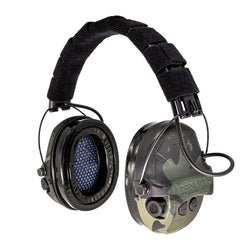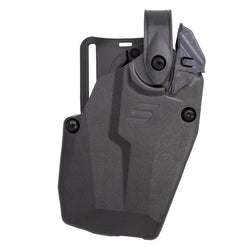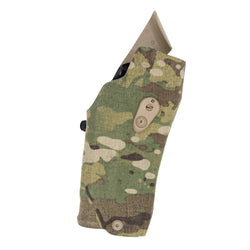I remember a meeting back in my Marine Corps days during which one unlucky soul had the misfortune of reporting that somebody had accidentally shot himself in the leg on the base’s pistol range.
It was a California police officer who was teaching a course, interestingly enough, and he put a bullet through his thigh while reholstering his pistol.
After the ensuing flurry of staff officers desperate to demonstrate their knowledge of Glock safety mechanisms and contrast them with those of our Beretta M9s, everyone agreed that there was only one way this incident came to pass. The officer had treated his pistol like it was unloaded, pointed it at something he did not intend to shoot, defeated the pistol’s safeties, and pulled the trigger.
Did he violate all four safety rules? Yes, although I’m positive he didn’t do it with the goal of taking a trip to the emergency room. I suspect this negligent discharge was a case of trigger ingress.
What Is Trigger Ingress?
Trigger ingress refers to any unwanted object or material entering the trigger guard area of a firearm, which can inadvertently engage the trigger and cause an accidental discharge.
Unless you have a very old, obscure firearm like the Colt Patterson revolver, your trigger isn’t just hanging off the bottom of your pistol unprotected. It has a trigger guard for a reason: to make sure nothing but your index finger can squeeze off a round.

Trigger guards are important but they aren’t perfect.
Poor technique can lead you to getting on the trigger early in your draw stroke, especially if you’re racing against a shot timer. When you return your pistol to the holster, a flawed design might even allow a piece of clothing to get caught inside the trigger guard and discharge your pistol. Others might even allow foreign objects (think coats, pack straps, and branches) to work their way inside the trigger guard while your hand is nowhere near the pistol.
Why Should I Care?
We all know that firearms should always be pointed in a safe direction. Think about that in the context of your holster — especially if you carry in the appendix position. That’s not what I’d call a safe direction, but we accept it because redundant layers of internal and external safety mechanisms are in place to prevent the pistol from firing.

When we holster a handgun, we need to trust that it’s not going to fire. That means the firearm itself has to incorporate safeties that make it impossible for the gun to fire without the trigger being pulled. That might look like a modern pistol’s internal safeties, a trigger safety, or an old-school thumb or grip safety.
But many of those systems rely on one assumption: that the trigger will remain untouched. If something besides your finger is able to get inside the trigger guard and pull the trigger, the firearm isn’t to blame; it functioned exactly as intended. In that case, the weak point is the holster.

Keep your finger (and everything else) off the trigger until you’re ready to fire.
So, why does this matter? Because sending a round through your own body is one of the worst things any gun owner can do.
What To Look For In A Holster
The first and easiest step in preventing trigger ingress is to make sure to use a holster that offers total coverage over the trigger area from the side. Old West-style rigs are a no-go.
Next, take a look from the back of the holster with a pistol inserted. Is there room for a finger or anything else to squeeze between the trigger guard and the holster? It should be a fairly snug fit.

Finally, consider the material the holster is made from. Leather looks great and is very comfortable but it’s not always rigid. Not all synthetic holsters can hold up to impacts or extreme temperatures. If there’s enough flex in the holster material, it’s possible for trigger ingress to occur.
Safarilaminate, STX, Safariseven, and Kydex holsters are the safest options because they hold their shape in all weather and temperature ranges you’re likely to encounter and can withstand an impressive amount of physical abuse.

The Bottom Line On Trigger Ingress
Trigger ingress doesn’t get talked about very often but it’s a serious problem. Preventing it should rank right up there with upholding the four weapon safety rules.
The good news is that trigger ingress is easy to prevent. A quality holster will provide all the security you need, and there is a huge array of options on the market.
Looking for a duty holster for a full-size pistol with all the bells and whistles? The Vault has you covered — and then some. Need something minimalist for a pocket pistol? You probably won’t even feel the Schema on your waist. There’s plenty in between those, so find what works for you and take trigger ingress off your list of things to worry about.









